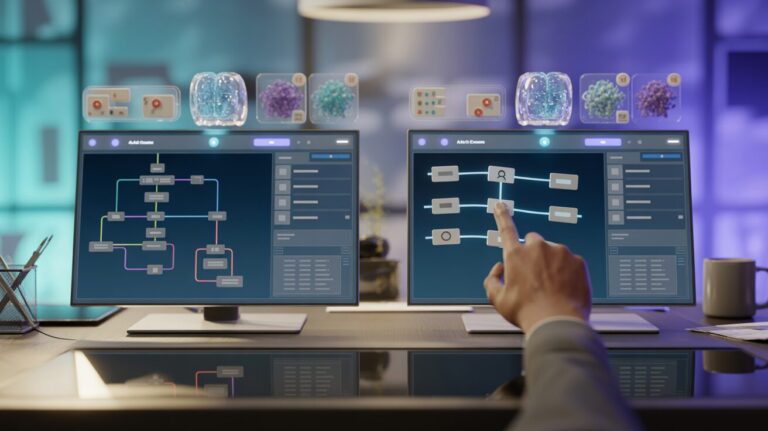Table of Contents
- Introduction to Drag-and-Drop AI Platforms
- What Are Drag-and-Drop AI Platforms?
- Benefits of Using No-Code AI Solutions
- Top Drag-and-Drop AI Platforms Compared
- Feature Comparison Matrix
- Real-World Use Cases and Applications
- How to Choose the Right Platform for Your Needs
- The Future of Drag-and-Drop AI Development
- Conclusion
The artificial intelligence revolution is no longer confined to tech giants and specialized developers. Thanks to the emergence of drag-and-drop AI platforms, the power to create sophisticated AI applications is now within reach for professionals across all industries—regardless of coding experience. These intuitive platforms are democratizing AI development, allowing everyone from content creators and educators to small business owners and healthcare professionals to build custom AI solutions tailored to their specific needs.
As the demand for accessible AI tools continues to grow, numerous platforms have emerged promising to simplify the creation process. But which ones truly deliver on this promise? How do they compare in terms of features, usability, and capabilities? In this comprehensive comparison, we’ll explore the leading drag-and-drop AI platforms available today, analyzing their strengths, limitations, and ideal use cases to help you find the perfect match for your AI development journey.
Whether you’re looking to create an intelligent chatbot for customer service, build an AI advisor with specialized knowledge, or develop interactive quizzes powered by machine learning, this guide will provide the insights you need to make an informed decision about which platform can turn your AI vision into reality—no coding required.
Drag-and-Drop AI Platforms
Comprehensive Comparison for Non-Technical Users
What Are Drag-and-Drop AI Platforms?
Visual interfaces that enable non-technical users to build AI applications without coding by arranging pre-built components on a canvas.
Visual Builders
Intuitive interfaces for arranging components
Pre-built AI Modules
Ready-to-use components for AI tasks
Data Integration
Tools for importing and processing data
Key Benefits
Democratized Access
Makes AI accessible to non-technical professionals across industries
Reduced Development Time
Build AI applications in minutes or hours instead of months
Cost Efficiency
Eliminate need for expensive AI specialists and developers
Expert Empowerment
Domain experts can directly create AI solutions without intermediaries
Platform Comparison
| Platform | Primary Focus | Setup Time | Technical Requirement | Monetization |
|---|---|---|---|---|
| Estha | Custom AI applications across domains | 5-10 min | None | Comprehensive |
| Obviously AI | Predictive analytics for business data | 15-30 min | Basic data understanding | Limited |
| Durable | AI-generated business websites | 5-15 min | None | Limited |
| Necto | AI agents and workflow automation | 30-60 min | Basic workflow knowledge | Limited |
| Akkio | Business predictions and automation | 10-20 min | Basic data understanding | Limited |
Key Use Cases
Content & Marketing
Interactive quizzes, personalized content recommendations, brand-aligned chatbots
Education & Training
Virtual tutors, knowledge assessment tools, adaptive learning systems
Healthcare & Wellness
Symptom assessment tools, medication adherence assistants, wellness coaches
Why Estha Stands Out
Fastest setup time (5-10 mins) with drag-drop-link interface
Complete ecosystem with learning (EsthaLEARN) and monetization (EsthaSHARE)
Advanced customization to preserve brand voice in AI applications
No technical knowledge required—truly accessible to everyone
No coding or AI knowledge required
What Are Drag-and-Drop AI Platforms?
Drag-and-drop AI platforms represent a revolutionary approach to artificial intelligence development that removes traditional coding barriers. These no-code solutions use visual interfaces where users can build AI applications by literally dragging elements onto a canvas and connecting them to create functional workflows—much like assembling building blocks.
At their core, these platforms abstract away the complex programming and mathematical concepts that typically underpin AI systems. Instead of writing code in Python or R and working with machine learning frameworks like TensorFlow or PyTorch, users interact with pre-built components that represent various AI capabilities and data processing functions.
The key components typically found in drag-and-drop AI platforms include:
- Visual builders: Intuitive interfaces where users can arrange and connect components
- Pre-built AI modules: Ready-to-use components for common AI tasks like natural language processing, image recognition, or predictive analytics
- Connectors: Elements that facilitate data flow between different components
- Data integration tools: Features that allow users to import and process their own data
- Customization options: Settings that allow users to configure AI behavior without coding
These platforms effectively bridge the gap between sophisticated AI technology and everyday users who have valuable domain expertise but lack technical programming skills. By implementing visual programming paradigms, they enable subject matter experts to translate their knowledge directly into functional AI applications.
Benefits of Using No-Code AI Solutions
The surge in popularity of drag-and-drop AI platforms isn’t merely a technological trend—it represents a fundamental shift in who can create and deploy artificial intelligence solutions. These platforms offer numerous advantages that are transforming how organizations and individuals approach AI implementation:
Democratized Access to AI Technology
Perhaps the most significant benefit of no-code AI platforms is their ability to democratize access to advanced technologies. Professionals in marketing, education, healthcare, customer service, and countless other fields can now leverage AI without intermediate technical specialists. This broader access encourages innovation from diverse perspectives that might otherwise never have influenced AI development.
Dramatically Reduced Development Time
Traditional AI development cycles can take months or even years, involving requirements gathering, coding, testing, and deployment. Drag-and-drop platforms compress this timeline dramatically, allowing users to create functional AI applications in days or even hours. This acceleration enables rapid prototyping and iteration, letting creators test ideas quickly and refine them based on immediate feedback.
Cost Efficiency
Hiring AI specialists and data scientists is prohibitively expensive for many organizations, with salaries often exceeding $150,000 annually. No-code platforms significantly reduce this financial barrier by eliminating the need for specialized developers. Small businesses and startups can compete with larger enterprises by implementing AI solutions at a fraction of the traditional cost.
Subject Matter Expert Empowerment
Domain experts who thoroughly understand their field’s challenges can now directly create solutions without having their knowledge diluted through technical translation. A physician can build a diagnostic assistant, an educator can develop an interactive learning tool, or a financial advisor can create an investment recommendation engine—all without intermediaries who might misinterpret their specialized knowledge.
Reduced Technical Debt
Custom-coded AI solutions often create technical debt—the ongoing maintenance cost of updating and fixing complex code as requirements change. No-code platforms typically maintain their underlying technology infrastructure, reducing long-term maintenance burdens and allowing users to focus on improving functionality rather than fixing technical issues.
Top Drag-and-Drop AI Platforms Compared
The market for no-code AI development tools has expanded rapidly in recent years, with several standout platforms emerging as leaders in different niches. Each offers unique approaches to the challenge of making AI accessible. Let’s examine the top contenders and what sets them apart.
Estha
Estha stands out as a revolutionary platform in the drag-and-drop AI landscape, offering one of the most comprehensive ecosystems for non-technical users to create sophisticated AI applications. Unlike many competitors that focus solely on app creation, Estha provides a complete end-to-end solution that extends from development through deployment and monetization.
The platform’s core strength lies in its intuitive drag-drop-link interface, which allows users to build custom AI applications in just 5-10 minutes without any prior coding or prompting knowledge. This approach is particularly valuable for subject matter experts who want to translate their specialized knowledge into interactive AI tools without technical barriers.
Estha differentiates itself through its three-pillar ecosystem:
- EsthaLEARN: Provides comprehensive education and training resources to help users maximize the platform’s potential
- EsthaLAUNCH: Offers startup support and scaling resources for users looking to build businesses around their AI applications
- EsthaSHARE: Creates monetization and distribution channels, allowing creators to generate revenue from their AI creations
The platform excels at enabling diverse application types, including sophisticated chatbots, expert advisors, interactive quizzes, and virtual assistants—all of which can be embedded into existing websites or shared as standalone applications. This versatility makes Estha particularly well-suited for content creators, educators, small business owners, and professionals in specialized fields like healthcare or finance.
Estha’s approach to preserving brand voice and expertise in AI applications represents a significant advancement over general-purpose AI tools, allowing for truly personalized applications that reflect the creator’s unique knowledge and perspective.
Obviously AI
Obviously AI focuses primarily on making predictive analytics and machine learning accessible to business users without data science expertise. The platform specializes in transforming structured data into actionable predictions through an intuitive interface.
Key strengths include its automated machine learning capabilities, which analyze uploaded datasets to recommend optimal prediction models. Users can build models to predict customer churn, sales forecasts, inventory needs, and other business metrics by simply connecting their data sources and specifying what they want to predict.
The platform excels at numerical predictions and classification problems but offers less functionality for creating interactive AI applications like chatbots or knowledge-based systems. This makes Obviously AI particularly valuable for business analysts and operations teams who need to derive predictive insights from existing business data.
While powerful for its specific use case, Obviously AI has a narrower scope than more comprehensive platforms like Estha, focusing primarily on structured data analysis rather than broader AI application development.
Durable
Durable approaches no-code AI from a business website and online presence perspective. The platform uses AI to generate entire business websites, content, and basic automation rather than focusing on building standalone AI applications.
Its strength lies in rapid website creation and business presence development, using AI to generate appropriate content, designs, and basic functionality based on user inputs about their business type and preferences. This approach makes Durable particularly useful for small business owners and entrepreneurs who need to establish an online presence quickly.
The platform includes features for local SEO, appointment scheduling, and customer communications, but it doesn’t offer the depth of custom AI application development found in more specialized platforms. Durable represents more of an AI-powered website builder with some basic automation capabilities rather than a true AI application development platform.
For users looking specifically to create custom AI tools beyond website functionality, Durable’s capabilities may be limiting compared to more development-focused platforms.
Necto
Necto positions itself as a platform for building AI agents and workflows without code. It focuses on creating process automation and conversational agents that can perform specific business functions.
The platform’s strengths include its ability to connect to various data sources and third-party applications, allowing users to create AI solutions that integrate with existing business systems. Necto uses a visual flowchart-like interface where users can define conversational flows and decision trees.
Necto emphasizes business process automation and is particularly well-suited for customer service, sales, and operations teams looking to automate repetitive tasks and create basic conversational interfaces. However, it requires more technical configuration than some competitors when connecting to external systems and data sources.
While effective for workflow automation with conversational elements, Necto doesn’t offer the breadth of AI application types or the simplified creation process found in more comprehensive platforms like Estha.
Akkio
Akkio specializes in making AI predictions and automations accessible to business users. The platform focuses on rapid deployment of machine learning models for business intelligence purposes.
Its primary strength is the speed with which users can go from data to prediction, often in minutes rather than days or weeks. Akkio excels at classification and regression problems, making it valuable for sales forecasting, customer segmentation, and risk assessment applications.
The platform includes features for data preparation and model deployment, with options to integrate predictions into existing business tools through APIs and integrations. This makes Akkio particularly useful for business analysts and decision-makers who need quick insights from their data.
While powerful for its specific use cases, Akkio is more limited in creating interactive, knowledge-based AI applications or user-facing tools compared to more comprehensive platforms in the space.
Feature Comparison Matrix
To help you evaluate which platform best suits your needs, we’ve compiled this comprehensive feature comparison of the top drag-and-drop AI platforms:
| Feature | Estha | Obviously AI | Durable | Necto | Akkio |
|---|---|---|---|---|---|
| Primary Focus | Custom AI applications across multiple domains | Predictive analytics for business data | AI-generated business websites | AI agents and workflow automation | Business predictions and automation |
| Time to First Application | 5-10 minutes | 15-30 minutes | 5-15 minutes | 30-60 minutes | 10-20 minutes |
| Technical Knowledge Required | None | Basic data understanding | None | Basic workflow knowledge | Basic data understanding |
| Chatbot Creation | ✓ (Advanced) | ✗ | ✓ (Basic) | ✓ (Moderate) | ✗ |
| Predictive Analytics | ✓ | ✓ (Advanced) | ✗ | ✓ (Basic) | ✓ (Advanced) |
| Knowledge Base Creation | ✓ (Advanced) | ✗ | ✓ (Basic) | ✓ (Moderate) | ✗ |
| Website Integration | ✓ | ✓ | ✓ (Native) | ✓ | ✓ |
| Monetization Options | ✓ (Comprehensive) | Limited | Limited | Limited | Limited |
| Educational Resources | ✓ (Extensive) | ✓ (Moderate) | ✓ (Basic) | ✓ (Moderate) | ✓ (Moderate) |
| Support for Custom Brand Voice | ✓ (Advanced) | Limited | ✓ (Moderate) | Limited | Limited |
This comparison reveals the diverse strengths and specializations among today’s leading drag-and-drop AI platforms. While all aim to make AI more accessible, each platform has optimized for different use cases and user needs. Estha offers the most comprehensive ecosystem for non-technical users creating diverse AI applications, while competitors like Obviously AI and Akkio excel specifically at business predictions and data analysis.
Real-World Use Cases and Applications
The true value of drag-and-drop AI platforms becomes evident when examining how they’re being applied across different industries and scenarios. Here are some compelling real-world applications that showcase the potential of these no-code solutions:
Content Creation and Marketing
Content creators and marketers are using platforms like Estha to build interactive content experiences that engage audiences in new ways. Examples include personalized content recommendation engines that suggest articles based on user interests, AI-powered quizzes that generate custom results, and brand-aligned chatbots that answer common questions while maintaining consistent voice and tone. These applications help content teams scale their efforts while providing more personalized experiences.
Education and Training
Educators have embraced drag-and-drop AI to create adaptive learning tools that cater to individual student needs. Applications include virtual tutors that provide personalized explanations of difficult concepts, knowledge assessment tools that identify learning gaps, and interactive simulations that allow students to apply theoretical knowledge in practical scenarios. These AI-powered educational tools help extend the reach of educational expertise beyond traditional classroom limitations.
Small Business Operations
Small business owners with limited resources are leveraging no-code AI platforms to automate operations and enhance customer experiences. Applications include inventory forecasting systems that predict stock needs based on historical data, customer segmentation tools that identify high-value prospects, and virtual assistants that handle appointment scheduling and basic customer inquiries. These tools help small businesses compete more effectively with larger enterprises.
Healthcare and Wellness
Healthcare professionals are using drag-and-drop AI platforms to create patient-facing applications that extend their ability to provide care and guidance. Examples include symptom assessment tools that help patients understand when to seek care, medication adherence assistants that provide personalized reminders, and wellness coaches that offer customized lifestyle recommendations. These applications help bridge care gaps between appointments and make specialized knowledge more accessible.
Financial Services
Financial advisors and institutions are building AI applications that democratize financial guidance. Applications include retirement planning tools that provide personalized savings recommendations, budgeting assistants that analyze spending patterns and suggest improvements, and investment education resources that explain complex concepts in accessible language. These tools help extend financial literacy and planning capabilities to broader audiences.
Across these diverse applications, the common theme is empowerment—professionals using their domain expertise to create AI tools that extend their reach, scale their impact, and make their specialized knowledge more accessible without requiring technical development skills.
How to Choose the Right Platform for Your Needs
With multiple drag-and-drop AI platforms available, selecting the right one for your specific needs requires careful consideration of several key factors:
Define Your Primary Use Case
Begin by clearly defining what you want to accomplish with your AI application. Are you looking to build an interactive chatbot that reflects your expertise? Do you need predictive analytics based on business data? Or perhaps you want to create an educational tool that adapts to student progress? Different platforms excel at different types of applications, so identifying your primary goal will immediately narrow your options.
Assess Your Technical Comfort Level
While all drag-and-drop platforms aim to simplify AI development, they vary in their technical requirements. Some platforms like Estha require virtually no technical background, while others might assume familiarity with data structures or workflow concepts. Honestly evaluating your technical comfort level will help you choose a platform that matches your abilities and learning capacity.
Consider Integration Requirements
Think about where and how you plan to deploy your AI application. Will it need to integrate with an existing website? Connect to specific data sources? Work within particular business systems? Platforms offer different integration capabilities, from simple embed codes to comprehensive API access. Ensuring your chosen platform supports your deployment environment will prevent implementation roadblocks.
Evaluate Growth Potential
Consider not just your immediate needs but your future ambitions. If you’re starting with a simple application but envision expanding into more complex scenarios, you’ll want a platform that can grow with you. Look for platforms that offer scalability in terms of usage volume, feature capabilities, and potential for monetization if that aligns with your goals.
Prioritize Educational Resources and Support
The availability of learning resources, community support, and customer service can significantly impact your success with any platform. Comprehensive documentation, tutorial videos, responsive support teams, and active user communities all contribute to a smoother development experience, especially for beginners. Platforms like Estha that include dedicated educational systems (EsthaLEARN) demonstrate a commitment to user success.
Test Through Free Trials
Whenever possible, take advantage of free trials or demo versions to get hands-on experience before committing. The intuitive feel of a platform’s interface and workflow can make a significant difference in your productivity and satisfaction. A platform that makes sense to you personally will lead to better results than one that constantly feels counterintuitive, regardless of feature listings.
By methodically considering these factors, you can identify the drag-and-drop AI platform that best aligns with your specific needs, technical comfort level, and long-term goals—setting yourself up for success in your AI development journey.
The Future of Drag-and-Drop AI Development
As we look toward the horizon of no-code AI development, several emerging trends and advancements promise to further revolutionize what’s possible for non-technical creators:
Increasing AI Model Sophistication
The underlying AI models available through drag-and-drop interfaces continue to grow more sophisticated. As foundation models expand in capability, no-code platforms will expose these advancements to users, enabling increasingly complex applications without additional technical requirements. This progression will steadily narrow the gap between what can be accomplished by experienced AI developers versus no-code creators.
Domain-Specific Optimization
We’re likely to see increased specialization of drag-and-drop platforms for specific industries and use cases. Platforms optimized for healthcare, education, finance, or creative fields will emerge with pre-built components and workflows designed for the unique needs of these domains. This specialization will further reduce the learning curve and accelerate development for professionals in these fields.
Enhanced Collaboration Features
Future platforms will likely emphasize collaborative development, allowing teams of domain experts to work together on AI applications without technical bottlenecks. Imagine education teams collaboratively building adaptive learning systems or healthcare teams jointly developing patient support tools, each contributing their specialized knowledge through intuitive interfaces.
AI-Assisted Development
In a recursive twist, AI itself will increasingly assist in the creation of AI applications. We’re already seeing platforms that suggest next steps, recommend components, or even generate entire application sections based on natural language descriptions of desired functionality. This “AI creating AI” approach will continue to reduce friction in the development process.
Expanded Monetization Ecosystems
As more non-technical creators build valuable AI applications, platforms will expand their support for monetization and distribution. Marketplaces for AI applications, revenue-sharing models, and specialized launch support will become common features, creating sustainable ecosystems that reward innovation without requiring business development expertise.
These advancements collectively point toward a future where AI development becomes as accessible as website creation is today—a specialized skill transformed into a universal capability. Platforms like Estha are at the forefront of this transformation, working to ensure that the next wave of AI innovation comes not just from technical specialists but from diverse experts across all fields and disciplines.
Conclusion
The rise of drag-and-drop AI platforms represents a profound democratization of technology that’s changing who can participate in the AI revolution. These platforms remove the traditional coding barriers that once restricted AI development to technical specialists, opening the door for subject matter experts across all domains to create sophisticated applications that embody their unique knowledge and perspectives.
Through our comparison of leading platforms in this space, several key insights emerge:
First, the field offers diverse options optimized for different needs—from Estha’s comprehensive ecosystem supporting multiple application types to more specialized platforms focused on particular use cases like predictive analytics or business websites. This diversity ensures that users can find solutions aligned with their specific goals.
Second, the rapid development timelines enabled by these platforms—often reducing months of traditional development to mere minutes or hours—is transforming how quickly organizations can implement and iterate on AI solutions. This acceleration creates new opportunities for experimentation, innovation, and responsiveness to changing needs.
Finally, the expansion of who can create AI applications is introducing fresh perspectives and domain expertise previously untapped in AI development. As educators, healthcare professionals, content creators, and countless other specialists begin building AI tools that reflect their knowledge, we’re seeing applications emerge that address nuanced challenges in ways technical developers working alone never could.
As you consider which drag-and-drop AI platform might best serve your needs, remember that the most important factor is alignment with your specific goals, comfort level, and vision for how AI can extend your expertise. The right platform will feel intuitive to your workflow while providing the specific capabilities your applications require.
The future of AI development belongs not just to those who can code, but to anyone with valuable knowledge to share—and drag-and-drop platforms are the bridge making this inclusive future possible.
Ready to build your own custom AI application?
Create personalized AI solutions that reflect your expertise—no coding required.



